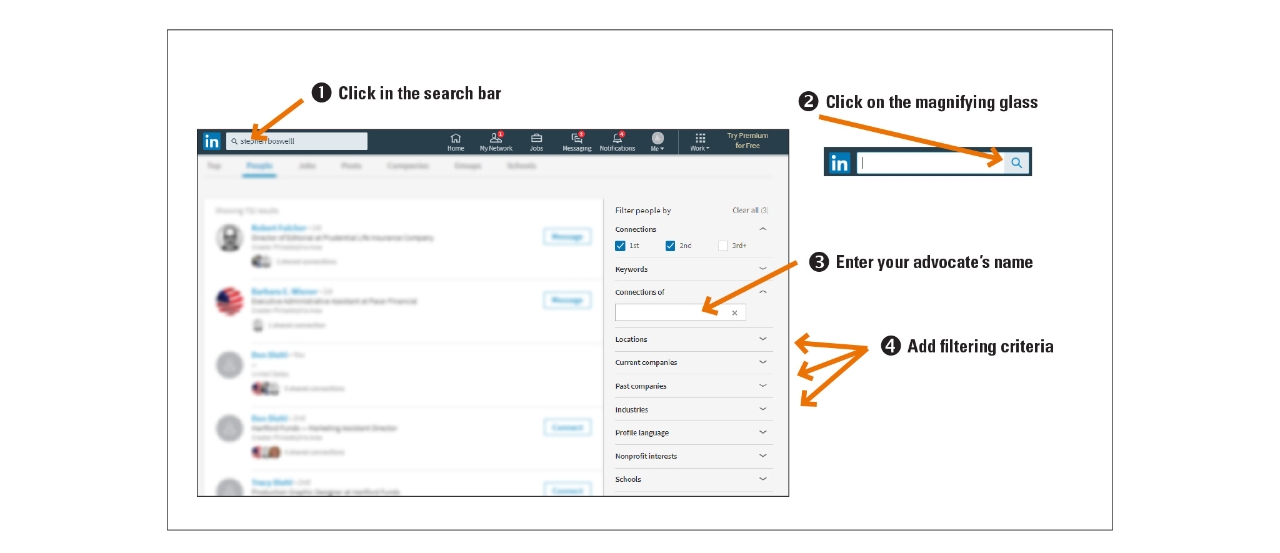When a friend gives us a strong recommendation to try a new restaurant, we usually give it a try. Why? We value our friend’s opinion. The same principle applies when one of your clients introduces you to one of their contacts. That contact may be more willing to meet you, and potentially do business, because of your mutual friend’s favorable opinion of you. This article outlines how you can use what Oechsli calls an Advocate Search on LinkedIn to get more introductions from clients.
What’s an Advocate Search?
An Advocate Search strategy uses LinkedIn to search your clients’ connections for people you’d like to meet, then asking your client for introductions to those connections. Oechsli says that the Advocate Search is one of the most practical ways to use LinkedIn to gain new clients.
Why Advocate Searches are so practical
You’re meeting with clients every day. Spending five minutes doing an Advocate Search before each meeting is a great way to find prospects. Since you already have a relationship with your clients, there’s a high probability that they're willing to introduce you to one of their connections.
What makes introductions so powerful is the credibility transfer that occurs when a client introduces you to one of their connections. From the perspective of the prospect, the introducer sees your meeting as mutually beneficial.
Despite the prospecting potential of Advocate Searches, many financial professionals aren’t using this technique. We polled nearly 300 financial professionals during our LinkedIn webcast and 82% said they had never done an Advocate Search.
Financial Professionals Webinar Poll
Have you ever done an advocate search?1

Doing an Advocate Search is easy. Here’s how (see diagram below):
- Think about a client you’re meeting with today
- Click on the magnifying glass beside the search window.
- Add filtering criteria for the type of connection you’d like to be introduced to, such as location, company, or job title.
- When you meet with your client, request an introduction to their connection. Here are five talking points from Oechsli you can use:
- The Social-Direct Approach
“Jim, I noticed you are connected to Tom Reynolds on LinkedIn. How well do you know him? I'd like to meet Tom. What would be the best way for you to introduce me socially?” - The Advice Request
“I was going to reach out to Tom Reynolds on LinkedIn and I noticed you were connected to him. I’d like your advice on the best way to meet him.” - The Ease-In Approach
“Jim, I noticed you're connected to Tom Reynolds on LinkedIn. Is he a good guy?” - The Basic Inquiry
“Jim, I saw you have some LinkedIn connections who look like the type of people we work with. In particular, I noticed Tom Reynolds. How well do you know him? Do you think he is someone I should be talking to?” - The Targeted Company approach
“Hey, I notice that you’re connected to Tom Reynolds on LinkedIn. What would be the best way to introduce me socially? We love to work with XYZ company, etc.
- The Social-Direct Approach
- Use what you learn from your client’s responses to initiate an introduction.
You might be wondering if your clients will really introduce you
Oechsli research on the topic shows that 83% of financial professionals who’ve acquired business through LinkedIn leveraged introductions. How do they do it? A reported 74% asked their client directly to be introduced.2
Oechsli research also revealed that clients are more likely to introduce you to their LinkedIn connections if you have both a business and social relationship. In a purely business relationship, 57% of clients would accommodate this request. If there's both a business and social relationship, 85% of clients would introduce their financial professional to one of their LinkedIn connections.3 For ideas to help you create social relationships with clients, check out page 6 of The Affluent Mindset workbook. You can download it at hartfordfunds.com/affluent.
Start leveraging client opinions
Your clients’ opinion of you can mean a lot to their LinkedIn connections. Start doing Advocate Searches before client meetings then use that intel to initiate introductions to your clients’ connections.
Next Steps:
Ask five clients for introductions using the Advocate Search method.
1Source: Mastering LinkedIn webinar, 9/29/17. Most recent data available.
2,3Source: Oechsli, 2017. Most recent data available.
Oechsli is not an affiliate or subsidiary of Hartford Funds.






